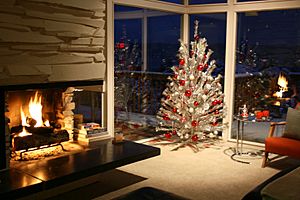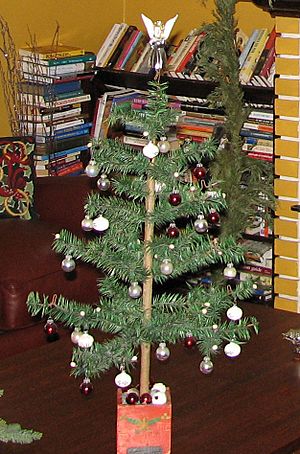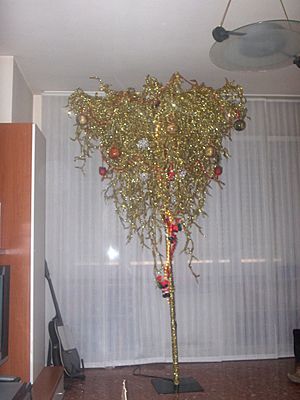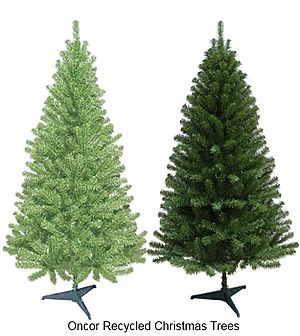Artificial Christmas tree facts for kids

An artificial Christmas tree is a fake tree, usually made to look like a pine or fir tree. People use them instead of real trees for Christmas. The very first artificial Christmas trees were wooden pyramids or trees made from feathers. Both of these ideas came from Germany. Today, most fake trees are made from a type of plastic called polyvinyl chloride (PVC). But there are also other kinds, like shiny aluminum trees and trees that light up with fiber optics.
Contents
History of Artificial Christmas Trees
The idea for artificial Christmas trees started in Germany in the 1800s. The first ones were made from goose feathers that were dyed green. Germans started making these feather trees partly because they were worried about too many real trees being cut down (this is called deforestation).
Feather trees became very popular in the early 1900s. They even came to the United States and were liked there too. Before feather trees, some of the first artificial trees in the U.S. were wooden, pyramid-shaped trees lit with candles. These were made in Bethlehem, Pennsylvania, by a group called the German Moravian Church in 1747.
Different Kinds of Artificial Trees
Feather Trees
Feather Christmas trees started in Germany and became popular in the U.S. They were made by attaching green-dyed goose feathers to wire branches. These branches were then wrapped around a central wooden stick, which was the "trunk." Feather trees came in many sizes, from tiny 2-inch (5 cm) ones to large 98-inch (2.5 m) trees sold in stores in the 1920s.
Often, the branches had fake red berries that could hold candles. The branches were spread out to prevent fires and leave room for decorations. People liked feather trees because they didn't need a trip to buy a real tree and didn't drop messy needles.
In 1930, a British company called Addis Housewares made the first artificial Christmas tree from brush bristles. These trees were made from the same animal-hair bristles used in toilet brushes, but they were dyed green.
Aluminum Trees

Aluminum trees were first made in the United States in Chicago in 1958. Most of them were produced in Manitowoc, Wisconsin. These shiny trees were very popular from when they first appeared until about 1965. That year, a TV special called A Charlie Brown Christmas showed aluminum trees in a negative way. Many people believe this caused their sales to drop.
Plastic Trees
Most artificial Christmas trees today are made from polyvinyl chloride (PVC) plastic. PVC trees are made to resist fire, but they are not completely fireproof. A lot of these trees are made in China. For example, from January to August 2005, the United States imported $69 million worth of artificial trees from China.
Trees that come with lights already on them, called prelit trees, are very popular. They make decorating easier because you don't have to string your own lights. Some popular lights include small incandescent bulbs and LED lights. LED lights are great because if one bulb goes out, the whole string usually stays lit. Prelit trees must meet safety rules for electrical products.
Plastic trees can be "frosted" to look like snow or "glittered" for sparkle. Some are even made for outdoor use with special sun-resistant materials. You can find plastic trees in many colors, and some even came with built-in speakers and an MP3 player.
Companies like Mountain King and Balsam Hill make PVC trees that look very real. They try to copy the look of trees like Douglas fir or Ponderosa pine. In the 1990s, trees started to look and even smell more realistic. Many newer models have lights already on them and branches that just snap into place. More recently, some companies use a special plastic called polyethylene (PE) that is molded from real tree branches to make them look even more natural.
Other Types of Trees
Artificial tree styles are always changing. Many unique and designer trees have appeared. Fiber optic trees come in two main kinds. One looks like a regular Christmas tree but has tiny lights at the end of its branches. The other type is made entirely of thin fiber optic cables, creating a tree that is mostly light. A man named David Gutshall received a patent for this second type of fiber optic tree in 1998.
One company in Dallas sells "holographic mylar" trees in many colors. You can also find tree-shaped decorations made from things like cardboard, glass, or ceramic for tabletops. Upside-down artificial Christmas trees were first used as a clever way to sell more decorations. They allowed shoppers to get closer to ornaments in stores and also created more floor space for other products. There were three kinds of upside-down trees: those hung from the ceiling, stand-alone ones, and half-trees attached to walls.
Artificial Trees in Culture
Putting up and decorating a Christmas tree is a big part of the holiday for many families. It's a tradition that brings back happy memories, and some people feel a special connection to real trees. However, as many things became plastic, so did Christmas trees. This led to the creation of the artificial Christmas tree, which has become very popular.
The demand for fake trees has grown a lot. Reports show that sales of real trees dropped by 34 percent in one decade, while sales of fake trees went up by 30 percent in just one year, reaching 9.6 million trees. One reason for this is cost. Artificial trees can be cheaper in the long run. For example, one fake tree might cost 70 percent less than buying ten real trees over the same amount of time. This, along with how easy new technologies are, has helped the artificial Christmas tree become a holiday favorite.
In 1992, about 46 percent of homes in the United States that had Christmas trees used artificial ones. Twelve years later, in 2004, a poll found that 58 percent of U.S. homes used a fake tree instead of a real one. The discussion about real versus artificial trees has been common in the news. News articles often talk about how sales of real trees have gone down and sales of fake trees have gone up since the late 1990s.
The rise of artificial trees was noticed by the Christmas tree farming industry in the U.S. In 2004, they hired an advertising company to help boost sales of real trees. A 1975 study showed why people were starting to prefer fake trees. Reasons included safety, only having to buy one tree, and being better for the environment. But the biggest reason people gave was that artificial trees don't make a mess with needles.
How Artificial Trees Are Made
Most artificial Christmas trees are made in the Pearl River Delta area in China. Between January and September 2011, over $79.7 million worth of artificial Christmas trees were sent to the United States. In the same period in 2012, this number jumped to $139 million. People who promote artificial trees say they are handy, can be used again, and are better quality than older fake trees. They also point out that some apartment buildings don't allow real trees because of fire worries.
There's also a big market for artificial Christmas trees in Poland. About 20 percent of all Christmas trees sold there are artificial, and many are made by families in Poland. One producer from Koziegłówki said that almost every other house in his area made artificial trees. The trees are made from a special film, mostly imported from China or Thailand. Whole families help make them, and the trees are sold all over Poland, with some even going to the Czech Republic and Slovakia. The main place for artificial Christmas tree production in Poland is in Piła.
Environmental Concerns
General Issues
People often discuss how artificial trees affect the environment. Generally, those who grow real trees say that artificial trees are worse for the environment than natural ones. On the other hand, groups like the American Christmas Tree Association argue that artificial trees are not more harmful. They say that the PVC plastic used in Christmas trees can be recycled well. However, one researcher called the idea that artificial trees are eco-friendly an "urban myth."
Lead in Older Trees
In the past, a metal called lead was sometimes used in PVC plastic to make it stronger. However, Chinese laws now forbid this. Most PVC materials for artificial Christmas trees now use tin instead of lead. Lead was found in some Chinese toys that were recalled in 2007.
A study in 2004 found that artificial trees usually don't cause much health risk from lead contamination. But it also said there could be "worst-case scenarios" where young children might face major health risks. The main author of that study, Dr. Richard Maas, said in 2005: "We found that if we leave one of these trees standing for a week, and we wipe under the tree we'll find large amounts of lead dust in many cases under the tree."
In 2007, U.S. Senator Charles Schumer asked the Consumer Products Safety Commission to check lead levels in artificial trees imported from China. There are lead-free artificial Christmas trees available. For example, one U.S. company uses barium instead of lead in its PVC trees. A 2008 report from the United States Environmental Protection Agency found that as the PVC in artificial Christmas trees gets older, it can start to break down. The report said that out of 50 million artificial trees in the U.S., about 20 million were 9 years old or more. This is when lead contamination levels can become unsafe.
See Also
- Artificial plants
- "Attack of the Mutant Artificial Christmas Trees"
- Christmas tree production
- Sri Lankan Christmas tree, tallest artificial Christmas tree





